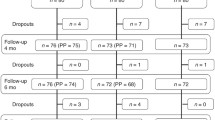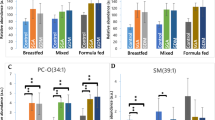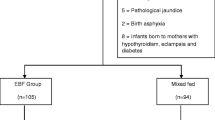Abstract
Previous studies have shown that the cholesterol and apoprotein concentrations in newborn plasma are dependent on the degree of saturation (polyunsaturated/saturated fatty acids ratio) of the dietary fats. In the present study we compare the influence on the lipoprotein patterns of breast-feeding and of two adapted formulae with a similar P/S ratio in 30 infants. The lipoprotein distribution and composition were investigated by density-gradient ultracentrifugation at days 0, 7 and 30.
The lipoprotein patterns were quite comparable at 0 and 7 days in the three groups. We found low VLDL and LDL and relatively elevated HDL concentrations with a high percentage of HDL2. A significant increase of both VLDL and LDL was observed between 0 and 7 days. The VLDL concentration in the breast-fed infants subsequently decreased between 7 and 30 days to a value close to that measured at birth. The infants receiving an adapted formula had significantly higher VLDL and lower LDL at 30 days compared to breast-fed children. HDL concentrations were not significantly different whereas the HDL2 percentage was significantly lower in the infants receiving the adapted formulae.
These data further support the hypothesis that the lipoprotein patterns in infants are sensitive to the type of nutrition and that breast-feeding induces specific lipoprotein patterns compared to adapted milk formulae.
Similar content being viewed by others
Abbreviations
- VLDL:
-
very-low-density lipoproteins
- IDL:
-
intermediate density lipoproteins
- LDL:
-
low density lipoproteins
- HDL:
-
high density lipoproteins
- FFA:
-
free fatty acid
- P/S:
-
polyunsaturated/saturated fatty acids
References
Blanche P, Gong E, Forte T, Nichols A (1981) Characterization of high-density lipoproteins by gradient gel electrophoresis. Biochim Biophys Acta 665:408
Foreman J, Karlin J, Edelstein C, Juhn D, Rubenstein A, Scanu A (1977) Fractionation of human serum lipoproteins by single-spin gradient ultracentrifugation: quantification of apolipo-proteins B and AI and lipid components. J Lipid Res 18:759
Guthrie HA, Picciano MF, Sheehe D (1977) Fatty acid patterns of human milk. J Pediatr 90:39
Hall B (1979) Uniformity of human milk. Am J Clin Nutr 32:304
Harzer G, Haug M, Dieterich I, Gentner PR (1983) Changing patterns of human milk lipids in the course of the lactation and during the day. Am J Clin Nutr 37:612
Lopes-Virella MF, Stone P, Ellis S, Colwell J (1977) Cholesterol determination in high-density lipoproteins separated by three different methods. Clin Chem 23:882
Mellies MJ, Burton K, Larsen R (1979) Cholesterol, phytosterols and polylunsaturated fatty acid ratios during the first twelve months of lactation. Am J Clin Nutr 32:2383
Mellies MJ, Ishikawa TT, Gartside PS (1979) Effects of varying maternal dietary fatty acids in lactating women and their infants. Am J Clin Nutr 32:299
Nillson J, Mannickarottu V, Edelstein C, Scanu A (1981) An improved detection system applied to the study of serum lipoproteins after single-step density ultracentrifugation. Anal Biochem 110:342
Patsch JR, Karlin JB, Scott LW, Smith L, Gotto AM (1983) Inverse relationship between blood levels of high density lipoprotein subfraction 2 and magnitude of postprandial lipemia. Proc Natl Acad Sci USA 80:1449
Rosseneu M, Vercaemst R, Vinaimont N, Van Tornout P, Henderson L, Herbert P (1981) Quantitative determination of the human plasma apolipoprotein AI by immunonephelometry. Clin Chem 27:856
Rosseneu M, Vinaimont N, Vercaemst R, De Keersgieter W, Belpaire F (1981) Standardization of immunoassays for the quantitation of plasma apo B protein. Anal Biochem 116:204
Rosseneu M, Vinaimont N, Musliner TA, Bernier D, Herbert PN, Belpaire F (1984) Quantification of the human plasma apo AII protein by immunonephelometry. Clin Chem 30:234
Rosseneu M, Vercaemst R, Steinberg K, Cooper G (1983) Evaluation and standardization of apolipoprotein B immunoassays. Clin Chem 29:427
Rosseneu M, Van Biervliet JP, Bury J, Vinaimont N (1983) Isolation and characterization of lipoprotein profiles in newborns by density gradient ultracentrifugation. Pediatr Res 17:788
Van Biervliet JP, Vercaemst R, De Keersgieter W, Vinaimont N, Caster H, Rosseneu M (1980) Evolution of lipoprotein patterns in newborns. Acta Paediatr Scand 69:583
Van Biervliet JP, Vinaimont N, Caster H, Vercaemst R, Rosseneu M (1981) Plasma apoprotein and lipid patterns in newborns. Influence of nutritional factors. Acta Paediatr Scand 70:851
Author information
Authors and Affiliations
Rights and permissions
About this article
Cite this article
Van Biervliet, J.P., Rosseneu, M. & Caster, H. Influence of dietary factors on the plasma lipoprotein composition and content in neonates. Eur J Pediatr 144, 489–493 (1986). https://doi.org/10.1007/BF00441745
Received:
Accepted:
Issue Date:
DOI: https://doi.org/10.1007/BF00441745




